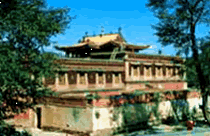Qingdao
 Qinghai (Green Sea) Province is situated in the northeast part of Qinghai-Tibet Plateau, where the Yangtze River and the Yellow River originate. The highway to Lhasa is asphalted, the highest highway in the world. Wild antelope, yak, donkeys, camels, lynx, deer and pheasant roam freely over the vast grass lands. Its capital city is Xining (Western Peace) and it has large lamaseries and mosques to offer. The earliest residents of Qinghai were the Qiang people and the province is now inhabited by people of various ethnic origins. Its warm-hearted people, rustic life style and customs, places of historical interest as well as its plateaus, snow peaks, glaciers, great lakes, forests and grassland attract tourists from all over the world.
Qinghai (Green Sea) Province is situated in the northeast part of Qinghai-Tibet Plateau, where the Yangtze River and the Yellow River originate. The highway to Lhasa is asphalted, the highest highway in the world. Wild antelope, yak, donkeys, camels, lynx, deer and pheasant roam freely over the vast grass lands. Its capital city is Xining (Western Peace) and it has large lamaseries and mosques to offer. The earliest residents of Qinghai were the Qiang people and the province is now inhabited by people of various ethnic origins. Its warm-hearted people, rustic life style and customs, places of historical interest as well as its plateaus, snow peaks, glaciers, great lakes, forests and grassland attract tourists from all over the world.
Qinghai is a huge, empty and wild place in the middle of China while its population is just 4.5 million. It is surrounded by Xinjiang, Gansu, Sichuan and Tibet; it covers a total area of over 720,000 square kilometers. There are lots of minority people living in Qinghai, including Tibetans, Hui, Salar, Tu, Mongol and Kazakh. Qinghai's provincial capital is Xining.
The city of Xining has lush green valleys and plentiful annual rainfall, this is also the only part of Qinghai where sustainable agriculture takes place. To the west and south is a three-thousand-metre plateau and it's bitterly cold for half the year. People there graze cattle and sheep in those high pastureland. To the northwest is an arid basin, where mineral deposits and oil were discovered. Now the area supports extensive mining.
There are places of natural beauty in Qinghai, including Qinghai Lake, Bird Island, Kunlun Mountains and the road to Tibet.
Recommended Scenic Spots
Qinghai Lake
Qinghai Lake, known as the Western Sea in ancient times, is a  somewhat surreal-looking saline lake to the west of Xining. It's the largest lake in China and contains huge numbers of fish.
somewhat surreal-looking saline lake to the west of Xining. It's the largest lake in China and contains huge numbers of fish.
The main attraction is Bird Island on the western side of the lake, about 300km from Xining. It's a breeding ground for thousands of wild geese, gulls, cormorants, sandpipers, extremely rare black-necked cranes and many other bird species. Perhaps most interesting of them are the bar-headed geese. These hardy birds migrate high over the Himalaya to spend winter on the Indian plains, and have been spotted flying at altitudes of 10,000m. You will see birds in quantity only during the breeding season - between March and early June.
Despite its name, Bird Island is not an island, but used to be before the lake shore receded and made it part of the mainland. There is one small island, Haixinshan, and for 45 Yuan you can take a boat trip from Bird Island around the lake that takes in this and other sights.
It gets chilly at night so bring warm clothing. The lake water is too salty to drink, so be sure to carry a sufficient supply if you intend to do any hiking. There are nomads around the lake -most are friendly and may invite you in for a cup of tea in their tents. There is a 52 Yuan entry fee to the Bird Island area.
Ta'er Monastery

One of the six great monasteries of the Yellow Hat sect of Tibetan Buddhism, Ta'er Monastery (or Kumbum in Tibetan) is found in the town of Huangzhong, a mere 26 km south of Xining. It was built in 1577 on sacred ground-the birthplace of Tsong Khapa, founder of the Yellow Hat sect.
The monastery is noted for its extraordinary sculptures of human figures, animals and landscapes carved out of yak butter. The art of butter sculpture probably dates back 1300 years in Tibet and was taken up by the Ta'er Monastery in the last years of the 16th century.
It's a pretty place and very popular with local tourists. An earthquake in 1990 and subsequent heavy snows threatened to destroy many of the buildings, and the Chinese government actually forked out 70 million Yuan for a major restoration project. But the place still maintains its historical atmosphere.
Go hiking in the surrounding area or follow the pilgrims clockwise on a scenic circuit round the monastery. Six temples are the buildings diagonally opposite the row of stupas. Photography is prohibited inside the temples.













No comments:
Post a Comment